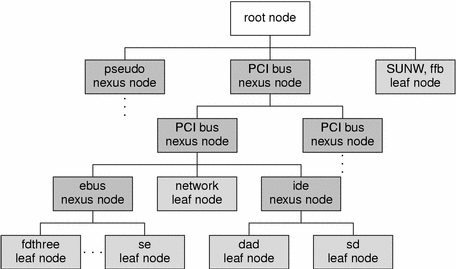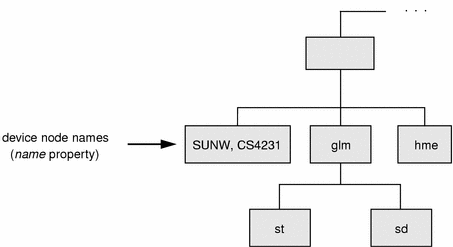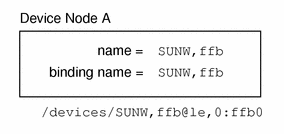Overview of the Device Tree
Devices in Solaris are represented as a tree of interconnected device information nodes.
Device Tree Components
The system builds a tree structure that contains information about the devices connected to the machine at boot time. The device tree can also be modified by dynamic reconfiguration operations while the system is in normal operation.
The tree begins at the “root” device node, which represents the platform. Below the root node are “branches” of the device tree, where a branch consists of one or more bus nexus devices and a terminating leaf device.
A bus nexus device provides bus mapping and translation services to devices that are subordinate to it in the device tree. PCI - PCI bridges, PCMCIA adapters, and SCSI HBAs are all example of nexus devices. The discussion of writing drivers for nexus devices is limited to that of developing SCSI HBA drivers (see Chapter 15, SCSI Host Bus Adapter Drivers).
Leaf devices are typically peripheral devices such as disks, tapes, network adapters, frame buffers, and so forth. Drivers for these devices export the traditional character and block driver interfaces for use by user processes to read and write data to storage or communication devices.
Each driver exports a device operations structure dev_ops(9S) that defines the operations that the device driver can perform. The device operations structure contains function pointers for generic operations such as attach(9E), detach(9E), and getinfo(9E). It also contains a pointer to a set of operations specific to bus nexus drivers and a pointer to a set of operations specific to leaf drivers.
The tree structure creates a parent-child relationship between nodes. This parent-child relationship is the key to architectural independence. When a leaf or bus nexus driver requires a service that is architecturally dependent in nature, it requests its parent to provide the service. This approach enables drivers to function regardless of the architecture of the machine or the processor. A typical device tree is shown in the following figure.
Figure 1–2 Example Device Tree

The nexus nodes may have one or more children, and the leaf nodes represent individual devices.
Displaying the Device Tree
The device tree can be displayed in three ways:
-
The libdevinfo library provides interfaces to access the contents of the device tree programmatically.
-
The prtconf(1M) command displays the complete contents of the device tree.
-
The /devices hierarchy is a representation of the device tree; use ls(1) to view it.
Note –
/devices displays only devices that have drivers configured into the system. prtconf(1M) shows all device nodes regardless of whether a driver for the device exists on the system.
The libdevinfo Library
The libdevinfo library provides interfaces for accessing all public device configuration data. See the libdevinfo(3DEVINFO) man page for a list of interfaces.
The prtconf Command
The prtconf(1M) command (excerpted example follows) displays all the devices in the system:
System Configuration: Sun Microsystems sun4u
Memory size: 128 Megabytes
System Peripherals (Software Nodes):
SUNW,Ultra-5_10
packages (driver not attached)
terminal-emulator (driver not attached)
deblocker (driver not attached)
obp-tftp (driver not attached)
disk-label (driver not attached)
SUNW,builtin-drivers (driver not attached)
sun-keyboard (driver not attached)
ufs-file-system (driver not attached)
chosen (driver not attached)
openprom (driver not attached)
client-services (driver not attached)
options, instance #0
aliases (driver not attached)
memory (driver not attached)
virtual-memory (driver not attached)
pci, instance #0
pci, instance #0
ebus, instance #0
auxio (driver not attached)
power, instance #0
SUNW,pll (driver not attached)
se, instance #0
su, instance #0
su, instance #1
ecpp (driver not attached)
fdthree, instance #0
eeprom (driver not attached)
flashprom (driver not attached)
SUNW,CS4231 (driver not attached)
network, instance #0
SUNW,m64B (driver not attached)
ide, instance #0
disk (driver not attached)
cdrom (driver not attached)
dad, instance #0
sd, instance #15
pci, instance #1
pci, instance #0
pci108e,1000 (driver not attached)
SUNW,hme, instance #1
SUNW,isptwo, instance #0
sd (driver not attached)
st (driver not attached)
sd, instance #0 (driver not attached)
sd, instance #1 (driver not attached)
sd, instance #2 (driver not attached)
....
SUNW,UltraSPARC-IIi (driver not attached)
SUNW,ffb, instance #0
pseudo, instance #0
The /devices Directory
The /devices hierarchy provides a name space representing the device tree. Following is an abbreviated listing of the /devices name space. The sample output corresponds to the example device tree and prtconf(1M) output shown previously.
/devices /devices/pseudo /devices/pci@1f,0:devctl /devices/SUNW,ffb@1e,0:ffb0 /devices/pci@1f,0 /devices/pci@1f,0/pci@1,1 /devices/pci@1f,0/pci@1,1/SUNW,m64B@2:m640 /devices/pci@1f,0/pci@1,1/ide@3:devctl /devices/pci@1f,0/pci@1,1/ide@3:scsi /devices/pci@1f,0/pci@1,1/ebus@1 /devices/pci@1f,0/pci@1,1/ebus@1/power@14,724000:power_button /devices/pci@1f,0/pci@1,1/ebus@1/se@14,400000:a /devices/pci@1f,0/pci@1,1/ebus@1/se@14,400000:b /devices/pci@1f,0/pci@1,1/ebus@1/se@14,400000:0,hdlc /devices/pci@1f,0/pci@1,1/ebus@1/se@14,400000:1,hdlc /devices/pci@1f,0/pci@1,1/ebus@1/se@14,400000:a,cu /devices/pci@1f,0/pci@1,1/ebus@1/se@14,400000:b,cu /devices/pci@1f,0/pci@1,1/ebus@1/ecpp@14,3043bc:ecpp0 /devices/pci@1f,0/pci@1,1/ebus@1/fdthree@14,3023f0:a /devices/pci@1f,0/pci@1,1/ebus@1/fdthree@14,3023f0:a,raw /devices/pci@1f,0/pci@1,1/ebus@1/SUNW,CS4231@14,200000:sound,audio /devices/pci@1f,0/pci@1,1/ebus@1/SUNW,CS4231@14,200000:sound,audioctl /devices/pci@1f,0/pci@1,1/ide@3 /devices/pci@1f,0/pci@1,1/ide@3/sd@2,0:a /devices/pci@1f,0/pci@1,1/ide@3/sd@2,0:a,raw /devices/pci@1f,0/pci@1,1/ide@3/dad@0,0:a /devices/pci@1f,0/pci@1,1/ide@3/dad@0,0:a,raw /devices/pci@1f,0/pci@1 /devices/pci@1f,0/pci@1/pci@2 /devices/pci@1f,0/pci@1/pci@2/SUNW,isptwo@4:devctl /devices/pci@1f,0/pci@1/pci@2/SUNW,isptwo@4:scsi
Binding a Driver to a Device
In addition to constructing the device tree, the kernel also determines the drivers that will be used to manage the devices.
Binding a driver to a device refers to the process by which the system selects a driver to manage a particular device. The driver binding name is the name that links a driver to a unique device node in the device information tree. For each device in the device tree, the system attempts to choose a driver from a list of installed drivers.
Each device node has a name property associated with it. This property can be assigned either from an external agent, such as the PROM, during system boot or from a driver.conf configuration file. In either case, the name property represents the node name assigned to a device in the device tree. The node name is the name visible in /devices and listed in the prtconf(1M) output.
Figure 1–3 Device Node Names

A device node can also have a compatible property associated with it. The compatible property (if it exists) contains an ordered list of one or more possible driver names or driver aliases for the device.
The system uses both the compatible and the name properties to select a driver for the device. The system first attempts to match the contents of the compatible property (if the compatible property exists) to a driver on the system. Beginning with the first driver name on the compatible property list, the system attempts to match the driver name to a known driver on the system. It processes each entry on the list until either a match is found or the end of the list is reached.
If the contents of either the name property or the compatible property match a driver on the system, then that driver is bound to the device node. If no match is found, no driver is bound to the device node.
Generic Device Names
Some devices specify a generic device name as the value for the name property. Generic device names describe the function of a device without actually identifying a specific driver for the device. For example, a SCSI host bus adapter might have a generic device name of scsi. An Ethernet device might have a generic device name of ethernet.
The compatible property allows the system to determine alternate driver names (like glm for scsi HBA device drivers or hme for ethernet device drivers) for devices with a generic device name.
Devices with generic device names are required to supply a compatible property.
Note –
For a complete description of generic device names, see the IEEE 1275 Open Firmware Boot Standard.
Figure 1–4 and Figure 1–5 show two device nodes: one node uses a specific device name and the other uses a generic device name. For the device node with a specific device name, the driver binding name SUNW,ffb is the same name as the device node name.
Figure 1–4 Specific Driver Node Binding

For the device node with the generic device name display, the driver binding name SUNW,ffb is the first name on the compatible property driver list that matches a driver on the system driver list. In this case, display is a generic device name for frame buffers.
Figure 1–5 Generic Driver Node Binding

- © 2010, Oracle Corporation and/or its affiliates
